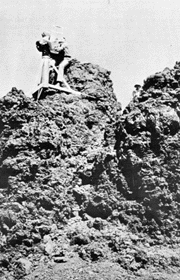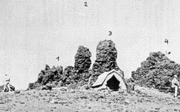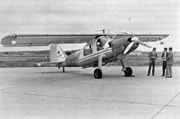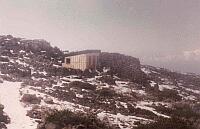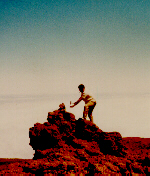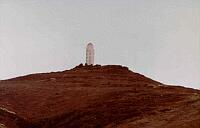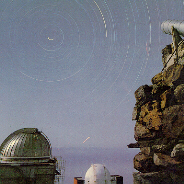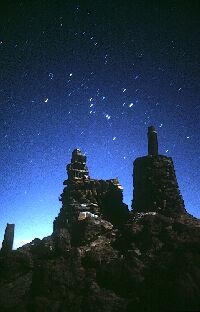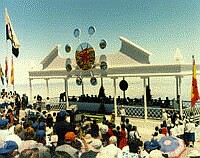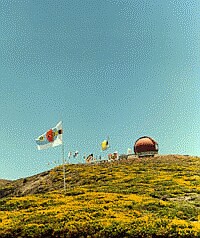 | |||
|
| Home > Public Information > Virtual Tour of the ING > The Beginnings |
The BeginningsA General Overview of the Beginnings of the Roque de Los Muchachos Observatory
The Canary Islands were discovered, as far as astronomy is concerned, by Charles Piazzi Smyth in 1856. Isaac Newton had written: "[Telescopes] cannot be so formed as to take away that confusion of rays which arises from the tremors of the atmosphere. The only remedy is a most serene and quiet air, such as may perhaps be found on the tops of the highest mountains above the grosser clouds." Following this principle Smyth tested El Teide, the main peak of Tenerife, for its suitability to sustain astronomical observations. In the course of a voyage lasting 113 days in 1856, he spent 65 days at Guajara and Alta Vista on the slopes of El Teide at heights of 2,714m and 3,262m respectively. He performed tests of seeing by separating double stars and extended the magnitude limit of his 18cm refractor by 4 magnitudes to 14th magnitude from its habitual 10th magnitude at Edinburgh. He made meteorological observations of humidity, dew point, windspeed and dust-haze as well as numerous special astronomical observations designed to demonstrate the quality of the sky, for example of solar prominences, zodiacal light, and solar spectra. 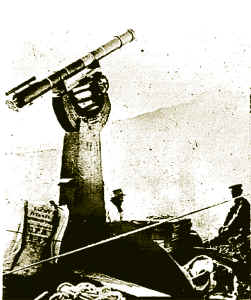 The search for the best site for the Northern Hemisphere Observatory (NHO) and the first visits to La Palma In January, 1967, Hermann Brück, Astronomer Royal for Scotland, first proposed the construction of a Northern Hemisphere Observatory (NHO) equipped with a 150-inch telescope. Exactly two years later, a committee under Fred Hoyle convened to examine the feasibility of such an undertaking, and by mid-1971 the project was in the planning stage. The choice of a site was strongly influenced by Merle Walker of Lick Observatory and his extensive investigation of the factors determining good observing conditions. Walker developed the technique of examining trails of circumpolar stars as a means of measuring the steadiness of the Earth's atmosphere. He carried out such observations at sites around the world. Early in 1971 he wrote that "the best seeing occurs at sites on peaks near sea-coasts having cold ocean currents offshore that reduce the height of the [temperature] inversion layer, and where the laminar air-flow set up over the ocean still persists" (Walker, 1971). And he also concluded that "mountain peaks on (small) islands in warm oceans may be good sites, provided that the peaks are sufficiently high to place the observer above the inversion layer..." The importance of an inversion layer is that clouds get trapped below it, leaving clear skies above. On the basis of all the available evidence, Walker produced a list of potentially favourable observing sites that included Tenerife and its near neighbour La Palma, as well as Madeira, Corsica, and Crete. As is often the case in scientific endeavours, several people reached the same conclusion simultaneously. Walker was not alone in recognizing the Canary Islands' potential. In 1971, John Alexander of the Royal Greenwich Observatory was investigating possible observing locations in the Mediterranean area, and his quest took him to La Palma in April 1971. His report, published later the same year, stated: "The ideal solution may be an international observatory site on the island of La Palma." Moreover, European solar observers, joining in an association known as JOSO (Joint Organization for Solar Observations) visited Tenerife in 1971 March, and on their second visit in November 1971, flew in a light aircraft over the mountain top of La Palma testing for atmospheric turbulence with temperature sensors. The possible sites on La Palma were inspected by several JOSO site testers in summer and autumn 1971. The highest point at El Roque de Los Muchachos (2426 m) was selected as a possible site. The first observations on La Palma The first astronomical (solar) observations on the Roque de Los Muchachos peak were carried out by a JOSO team consisting of Göran Hosinsky, Lars Staveland and Hubertus Wöhl from 2 to 21 July 1972 (Hosinsky, Staveland and Wöhl, 1972). The British site-testing teams were dispatched to Tenerife and La Palma in 1972 under the direction of the Royal Observatory Edinburgh (ROE). The survey on Tenerife was made at the well-developed site of the Observatorio del Teide. Conditions on La Palma were very different. Rising to almost 8,000 feet at its highest point - called Roque de Los Muchachos - the caldera's rim is a desolate region of scrub vegetation and volcanic ash. The site under investigation was Fuente Nueva, a small peak on the northern edge of the caldera adjacent to the Roque. The survey took place in August and September, 1972. This is an extract of probably one of the first publications with data taken at the Roque de los Muchachos Observatory (B McInnes, 1974) "The main work of the Project in the Canary Islands was done on the island of Tenerife; it seemed desirable to have some information also from the island of La Palma. A visit was made to the island during 1972 July 11 to 14 and decisions were made about the observational work that could easily be done there at that time. Dr Gough and Mr Heath then assembled the necessary equipment in Tenerife for a temporary outstation. They arrived at La Palma on July 28 with the Station 3 Land Rover carrying the equipment; construction work and transportation of the equipment to the site occupied the next few days; the observations began there on August 6 and ended on September 24. The highest point of the island is Roque de los Muchachos (2,423 metres, 7,949 feet). The site chosen for the observations was a peak called Fuente Nueva, situated about one kilometre north-east of Roque de Los Muchachos [...] This site was selected by Dr Gough in the expectation that there might be a more favourable airflow there than at the higher Roque de Los Muchachos, since the prevailing wind is from the north and there is a fairly uniform slope with a gradient of about 1 in 4 from Fuente Nueva down to the coast, which is about 9 kilometres (5.5 miles) to the north. Observations of the seeing were made using a Lick Polaris Trail Telescope, which was mounted on a pier constructed of concrete blocks and local rocks cemented together. The objective of the Polaris Trail Telescope was about 4 metres (13 feet) above the general ground level. In general, seeing observations were made each hour during the night and meteorological observations were made at the beginning of each seeing observation. The air temperature was read from an accurate sheathed thermometer which was housed in a louvered box. The wind speed was measured with a hand-held anemometer, held at about the height of the telescope objective. The wind direction was obtained from a wind vane which was mounted at about 5 metres (16 feet) above the general ground level. Since there was no road to the site, access was on foot, with mules to carry equipment and supplies, and the observers were housed in small tents. The walk from the nearest vehicle road to the site took between two and three hours." The results of this preliminary
testing campaign were analyzed by Walker and Bennet McInnes of ROE and
published in 1974. Their conclusion was that the "seeing conditions
at Izaña, while good, were not excellent." On the other hand,
reports from Fuente Nueva "indicate conditions as good or better than
those known at any other site." Additional factors, such as the number
of clear hours and the lack of light or atmospheric pollution singled
out the La Palma site as being exceptional. The JOSO came to a similar
conclusion. Professor Kiepenheuer of the Fraunhofer Institut in
Freiburg, Germanyand JOSO
leader became an enthusiastic advocate of La Palma at this time.
In 1974 August the Spanish authorities issued an invitation to form a Joint Astronomical Site Survey to undertake an international programme of site testing on the Canary Islands. A momentous meeting took place in 1974 December, when representatives of Denmark, Sweden, Germany and the United Kingdom were invited by the Rector of the University of La Laguna and the Presidents of the local Governments (Cabildos) of Tenerife and La Palma to discuss arrangements for the survey programme. Meanwhile, arrangements had already been made for the setting up of Polaris trail telescopes and meteorological equipment on La Palma and observations began on 25 November 1974 and ended in November1975 .
This encouraging progress came after a period of deep pessimism about the prospects for agreement on the use of La Palma. At the sixth meeting of the NHO Planning Committee in May 1973, Sir Martin Ryle complained about the lack of progress and suggested that UK universities could themselves move faster and more effectively both on the international and the technical questions. Dr M J Smith, who acted as a consultant to the Planning Committee, reported on Hawaii as almost the only possible site. Testing on Madeira (Ecumeada Alta peak) as an alternative started in October 1973. Spanish sites were no longer to be considered. Recovery from this deep gloom obviously depended on international politics, but it appears that several personal initiatives were also partially responsible. In March 1974 Prof S Edwards (Chairman of SRC) and Prof M F Walker visited the Consejo Superior de Investigaciones Científicas (CSIC) in Madrid and discussed the problem with Prof Masía, who was already well known for his help in international scientific affairs. Walker followed this visit with another in June. Prof F Sánchez, Director of the Observatory in Tenerife, had been encouraging the CSIC, the University and the local authorities to issue a joint invitation. A senior Spanish astronomer, Padre Romaña, was also active in overcoming the various political problems. At the meeting of December 1974, representatives of the various countries involved: Prof K O Kiepenheuer (Germany), Prof A A Wyller (Sweden), Dr K Gyldenkerne (Denmark), Prof H A Brück and F G Smith (UK) were shown the La Palma site from a light aircraft. F H Smith wrote: "A small hut with the waving figures of two site testers was the only sign of human activity on what is now a major European observatory. The weather was good and we were assured that this was typical. Everyone felt that this must be the site for the new observatory" (F G Smith, 1985). From that time onwards there was intensive action on three fronts: site testing, telescope design and the necessary international agreements. (see site tester's notes, Rein Bakker, on their work on site). The meeting of 1974 December also
revealed the intention of the Spanish astronomers and authorities to provide
the basic facilities, ie a road, electrical power and water for the new
observatory site. The project was to be regarded from the start as a cooperative
venture, with the overseas participants providing telescope time and training
for research astronomers in return for the use of the site and its facilities.
The formal agreements necessary to secure the rights and specify the duties
of the international participants were formulated two years later, when
Prof Primo, President of the CSIC, invited representatives of research
institutes in the various countries involved to Madrid.
The correct choice of instruments at an observatory is almost as important as its site. Observing time on large telescopes is notoriously oversubscribed. To devote all the available resources to a single large instrument would preclude observations that could be made with a smaller telescope. Thus, to make the best use of a good site requires the construction of a number of instruments of different apertures. The idea of building a very large reflector for faint-object work was retained. However, difficulties are always encountered in constructing efficient auxiliary devices, such as spectrographs, if the primary mirror is too large. As a result, it was determined that an aperture of about 180 inches (4.5 metres) was the optimum size. Upon investigating the availability
of a suitable mirror, it was found that Owens-Illinois already had a
165-inch (4.2 metre) Cervit disk in stock. This was the last of a batch
of blanks that included the primaries for the 3.9-metre Anglo-Australian
Telescope and the Cerro Tololo 4-metre telescope. Each successive disk
formed from the same mould came out slightly larger than its predecessor. The option of using a different ceramic material, Zerodur, was discarded due to its high production cost (Goodsell, 1977), and slicing Owen's blank to a 12 diameter-to-thickness ratio mirror, althoug feasible, was also discarded due to design constraints (Pope, 1978). A study of deflection and stress of this mirror was then carried out for the subsequent design of the supporting system (Mack, 1980). Therefore economic and technical considerations led to the choice of the 4.2m blank for what was to become known as the William Herschel Telescope. In addition, the same reasoning suggested that an altazimuth mounting was appropiate for such a telescope. This decision reduced the weight of the mounting by 120 tons and halved the height of the dome needed. While the WHT was being designed, new developments and ideas on telescope design came into the scene and as a consequence the design of the WHT was revised. After assesing all the possible options, it was decided to stay at the original design (Graham Smith, 1979) and purchase Owen Illinois' blank. In order to switch from primary focus to secondary mirro and avoid setting up a big crane to change the whole top end of the telescope, a novedous rotating top end ring was conceived (Pope, 1982). Spectroscopy has been, and is certain to remain, one of the principal tools of astrophysical research. Very high resolution spectroscopy can be carried out efficiently with an instrument smaller in size than the Herschel. This type of work is well suited to a 100-inch telescope. Thus, it was decided to move the Isaac Newton Telescope from its cloudy Sussex home, while upgrading it with a new 100-inch Zerodur mirror, an improved mounting, and a large Coudé spectrograph (see the article "Castle in the Sky – The Story of the Royal Greenwich Observatory at Herstmonceux" by Chas Parker for more information on the already working Isaac Newton Telescope). The third and smallest telescope at the NHO was to be a dual-purpose 1-metre reflector of novel design. The optics, devised by Charles Harmer and Charles Wynne of RGO, give the telescope a 1.5 degrees flat field for astrometric work. But, by removing a corrector and changing the secondary mirror, the system becomes a conventional Cassegrain for photometry or spectroscopy. Overall responsibility for the NHO project was put in the hands of the Royal Greenwich Observatory. The proposals for these three telescopes were accepted by the Science Research Council in November 1974; planning and design started at RGO immediately. The project team at RGO was headed by Mr W. A. Goodsell, the chief telescope designer was Mr J. D. Pope, and the Project Scientist was Mr G. A. Harding. Partnership: The Netherlands and Ireland As the design of the telescopes and domes progressed, it became clear that the costs of building, maintaining and improving the ING would be too high for UK resources alone. So two options were considered, either reducing the scale of the UK installations or finding international partners who could help both with money and with manpower. Fortunately two such partners were found. Dutch colleagues had already helped with site testing and they were aware of a forward-looking plan in which they hoped to build or gain access to new large telescopes overseas. The architect of the plan was Prof H van der Laan. At the IAU General Assembly in Montreal (1977) a basis for mutual advantage was worked out, and a momentous agreement was signed on 18June 1981 between the Netherlands Organisatie voor Zuiver-Wetenschappelijk Onderzoek (ZWO) and the UK SRC on cooperation in astronomy. Dutch colleagues became full partners, contributing both in cash and in manpower in proportion to the astronomical manpower in each country. The addition of 20% to the budget, with the addition of manpower to help commission the telescopes and to undertake the design and construction of instruments, allowed the project to continue undiminished. This partnership is symbolised by the naming of the 1-m telescope as the Jacobus Kapteyn Telescope. The collaboration is supervised by the Joint Steering Committee. The Director of Dunsink Observatory, Prof P A Wayman, provided the introduction to the second partnership. It happened that the arrangements for Irish astronomers to use the Boyden Observatory in South Africa were terminating and it also happened that the Dunsink astronomers were particularly interested in the kind of astronomy that could be done with the new 1-m telescope. The result was an agreement between the Dublin Institute of Advanced Studies and the SRC, whereby Ireland would pay a proportion of the costs in return for observing time. Technical help would also be provided by Dunsink; this agreement was immediately put into action with great benefit to the UK instrument designers. Analysis of all the testing data revealed clearly that Mauna Kea and Fuente Nueva were the best astronomical sites known. The difference between the two was slight. For example, the seeing was better than 1 arc second 36 percent of the time on Mauna Kea and 40 percent for La Palma. The two really significant drawbacks of the Hawaiian site for the British were the problems that observers would suffer from its much greater altitude and its distance from Europe. So, after many years searching, La Palma was finally chosen. On 26 May, 1979, almost 10 years after the first committee met to consider a Northern Hemisphere Observatory, a treaty governing its establishment was signed (The "Acuerdo Internacional en Materia de Astrofísica", BOE, 161, 6 July 1979). Spain agreed to let Denmark, Sweden, and Britain build on La Palma, in exchange for 20 percent of the observing time. On the Spanish side, a major reorganization of astronomical research had led to the founding of the Instituto de Astrofísica de Canarias (IAC) under the directorship of Francisco Sánchez. The IAC owns and operates on behalf of Spain the Izaña observatory and the new site on La Palma - now officially known as the Roque de Los Muchachos Observatory. The Danish contribution is the
Carlsberg Automatic Transit Circle. The Swedes wanted to build a 60-cm
stellar telescope and a solar tower with a 60-cm heliostat and 44-cm Cassegrain.
In fact, construction of these installations started within days of the
treaty's signing.
Photos of the construction and erection of the ING telescopes can be found here:
It's interesting to note that since the beginning astronomers were concerned about conserving the good Palmeran sky conditions. The following is a good example of the latter (Gietzen, 1982): "One of the reasons for selecting La Palma as the site for the installation of the UK's major optical telescopes was the comparitively minor interference with the quality of the night sky by urban lighting and overflying aircraft. Any increase in either of these factors will lead almost inevitably to a reduction in the observational utility of the site[...].
I would like co-operation in identifying 'early warnings' in order that action may in some instaces be started sooner.
There are two areas where every one can contribute:
1) I would like to be informed of any reports, whether in newspapers or elsewhere, of possible future increases in the level of artificial lighting in the island.
2) I would also like to start a record of the incidence of aircraft vapour trails in the vicinity of the site. Reports to be included in this would include date and time of observation and position and direction in at least crude terms. Regular visitors to the site are requested to co-operate in this."
In 1988 the Spanish Government approved the Sky Law in order to protect the Palmeran sky. The Oficina para la Protección del Cielo was then set up.
Name of the British telescopes on La Palma
At the meeting of the International Scientific Committee on Tenerife on 25 May 1984, Alec Boksenberg announced that the 1 metre telescope had been named the Kapteyn Telescope after Jacobus Kapteyn, the Dutch astronomer. The name was appropiate since he had worked on problems of galactic structure similar to those which the telescope was expected to attack. He also announced that the interim name UK Optical Telescopes woud be replaced by the name Isaac Newton Group. In the 1960's Britain's biggest telescope was named after the British scientist most highly regarded in the world. In the 1980's its best collection of telescopes continued to commemorate this man (Murdin, 1984).
The observatory on La Palma was
inaugurated by seven heads of state, or their representatives, on 29
June 1985. Attending were King Juan Carlos of Spain, Queen Beatrix of
the Netherlands, Queen Margrethe of Denmark, King Gustav of Sweden,
the Presidents of West Germany and of Ireland, and the Duke of Gloucester
representing Queen Elizabeth of the United Kingdom. After ceremonies
and banquets on Tenerife on June 28, the royal party and the guests
flew to La Palma on the morning of the 29th, to ascend to the Roque
de los Muchachos in perfect weather. The heads of state travelled from
telescope to telescope, dedicating each in front of a small audience.
The main ceremony, inaugurating the whole observatory, took place in
a large open-air auditorium. The audience included royal guests, astronomers,
engineers, Nobel Laureates, national and local dignitaries, Spanish,
Dutch, Danish, Swedish and British staff on the Roque, civil servants,
military officials and media representatives, in a gathering in which
protocol played a relatively minor part. Other events on the island
included the opening of the Convent of San Francisco in which there
was displayed an exhibition of Hispano-Arabic astronomical instruments
and maps, some loaned by the Old Royal Observatory, Greenwich.
Bibliography and other relevant documents
Francisco Armas, Rein Bakker, Cecilia Hosinsky, José Francisco Pérez Bravo, Guillermo Rodríguez Rodríguez, Lluís Tomas Roig are acknowledged for their kindness in provinding me with information on facts and people, apart from valuable photographic material.
| |||||||||||||||||
| Top | Back |
|

